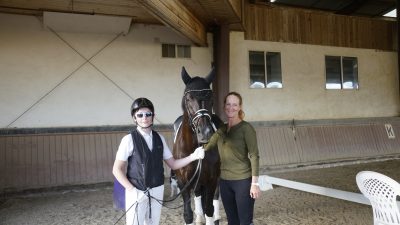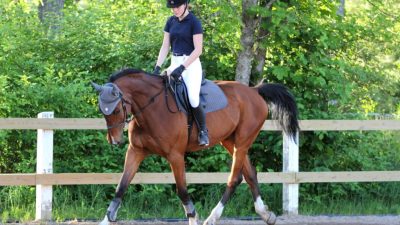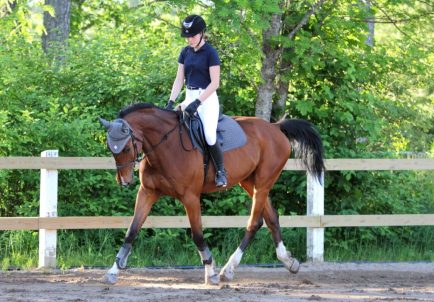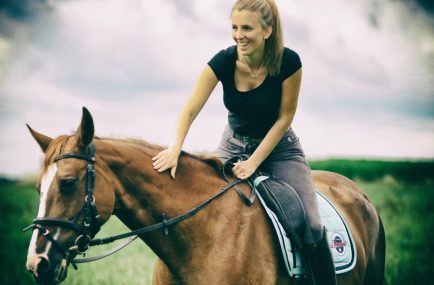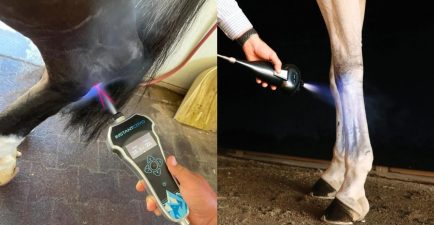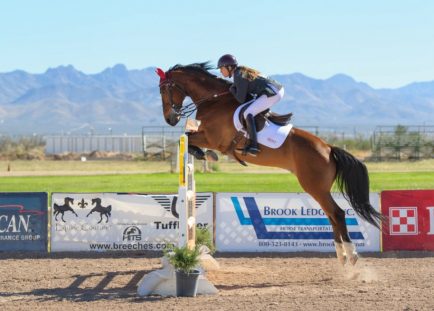The World Equestrian Center and Equestrian Management Agency featured a Master Class with US Dressage Olympian Sabine Schut-Kery, in Ocala, Florida April 15. Held on Saturday during and action packed CDI 3* and National Dressage Show, auditors were lined up early to get their seats in Arena 1 for a full day of focused learning.
Sabine is a German-American Dressage rider who represented the USA during the 2020 Tokyo Olympics. Together with the stunning stallion, Sanceo, helped bring the USA into team Silver Medal. Classically trained in Germany, she started her riding career in the USA as an exhibition rider primarily working with Friesians.
Her talent and training quickly elevated into competitive dressage, first bringing her own stallion Jorrit to the Grand Prix level, then the opportunities continued pour in.
Sabine is a well-respected member and competitor of the dressage world, as well as a highly respected clinician and a “Master of the Master Class”. For this event she had reviewed submitted videos, and met the riders the day before, but until they entered the arena in front of the audience on the day of the event, Sabine had not seen any of the horse and rider combinations that would be in front of her experienced eye that day.
“Sabine is an awesome clinician,” said auditor, dressage rider and trainer Louise Levesque. “I loved her precision of the basics. She made a difference in every horse.”
Exercises That Work and Why
A huge piece of the symposium that was greatly appreciated were the many exercises Sabine gave for riders to take home and utilize. As an example, she spent time explaining to the spectators the importance of turn on the forehand.

While this movement in any of the US national dressage tests, they are in the German tests. This exercise helps get the horses supple throughout the body and utilizing the correct muscles, bend, and flexion. An upper-level exercise Sabine displayed was important to get the right setup in between sequence half passes.
The demo rider was having trouble getting her horse shoulder-fore for the next half pass in a zig-zag. Sabine talked about how important it is to be able to move the shoulders, haunches, and rib cage separately from each other. She also discussed that having haunches leading in a test is a common and major point looser in a competition.
She had the demo rider perform her first half pass and then immediately go into shoulder-in while she cantered down the quarter line. Once her shoulder-in was balanced and established then she could continue on with her second half pass. After a couple of practices of the exercise, she was able to do her zig zag with the proper alignment.
Another upper-level movement Sabine discussed was the piaffe. She said how important it is to always keep the horse thinking forward. One thing, in particular, she said that I took away was the value of thinking of the horse piaffing with the hind legs. “A lot of riders want a flashy front end and forget about where all the power is coming from,” sad Sabine. “If you can keep that mindset, you will develop a better, stronger, and more correct piaffe.”
Diversity In Breeds For Dressage – Exercises for All
There were several varying mounts such as Lusitanos, Warmbloods, and Friesians. The Spanish breeds are more known for the quality of upper-level movements versus the quality of gaits. They can sometimes struggle to get their scores up, especially in the walk and canter.
To improve this, Sabine talked about how keeping the horse engaged in the shoulder in during the walk work can help them relax and gain a more natural four-beat rhythm. She also discussed how the counter canter can improve the quality of the canter. This helps the horse gain strength and to be balanced even when they aren’t in theory completely balanced.
Sabine started almost all of the riders with a shallow leg yield from the quarter line or centerline spanning almost the entire long side. She said she loves this exercise and does it with her horses before doing any harder movements. She talked about how it gets the horse crossing, using their body correctly, being on the rider’s aids, and into the outside rein.
Those are just a couple of the reasons to start your ride off with this amazing exercise. I believe spectators found these exercises very useful and will definitely be taking them home for their own horses.
Fairness and Consistency is The Key
Sabine Schut-Kery always talks about the importance of fairness towards the horses. They can’t learn everything in one training session. Each session is so specific to the different horses, anything from an older Grand prix horse to a three-year-old just starting under saddle.
She talked about the rider’s responsibility to not give the horse miscommunications. She discussed with some of the demo riders that they can’t say something is acceptable one time and not another. “You have to be on yourself about giving the correct cues every time. It wouldn’t be on the horse to jig in the walk if you let them do it some of the time as opposed to just not in the show ring.”
The Importance of the Reward
“We all reward our horses when they do a perfect 10-movement, but what about the steps we take to get there? Yes, petting a horse and giving them a carrot after the ride is a reward, but the horse isn’t going to remember each specific thing it did when they get a carrot after.”

Sabine talked about giving rewards such as breaks when they do something better than they did the last couple of times. She stated that you don’t want to drill the same exercise over and over when they are doing it well or better than they normally do it.
Before the ‘good’ turns ‘bad’, you must eliminate the bad. To explain, if you get something better and they don’t do a particular bad habit, then leave it before you get that bad habit. Slowly the horse will learn that they don’t need that bad behavior.
If every time your horse does something good and you reward him by dropping the reins and letting him walk, then you might be causing bad behaviors. In the show ring, he might pull the reins out of your hands or jig into the walk, or even break out of gaits.
Training the Young Horse
She talked about how not every ride is 45 minutes of drilling movements. Sabine said with her young horses she may only do 20-30 minutes of work if she achieved what she was looking for in the ride.
This might be only 3-4 times a week, while the other days are cross-training such as a ride on the gallop track or some jumping. It is important to get a young horse properly muscled for the work they are doing.
When you have been riding a horse at least a couple of times you should start to notice what they can handle and when they are done. It’s important to know what works for each horse because they can be extremely different from your typical mount. It’s the rider’s responsibility to go into the ride with clear and collected thoughts along with a plan.
Transitions,Transitions and More Transitions
It’s not fair to get on your horse when you aren’t fully focused on them and what you want to achieve. Transitions, transitions, and more transitions. A lot of the top riders talk about the number of transitions they do in each ride.
Sabine emphasized the importance of transitions in training along with in your test. Transitions not only between gaits but between movements are what make the test flow and achieve high scores. Every single transition in a test and at home counts.
Pushing Power

Every transition should have intention and be precise. You need to organize for each one as well, which may vary for every horse. Some might take three strides, others may take five or more depending on your specific horse. Another important detail Sabine discussed was pushing power.
You have to maintain the pushing power in the transition, especially a transition like a half halt. If your horse isn’t maintaining the pushing power, it won’t maintain its gaits or collection. They either need more training or more strength, or a combination of other things as well.
When talking about a lower-level or young horse, the transitions may not be as trained, but for the upper-level horses, you should be able to perform transitions for a 10. If you are doing movements in any of the FEI levels, your transitions should be perfect. You should also be riding every movement for that perfect 10. For example one of Sabine’s demo riders was struggling with the quality of the canter. Sabine wanted her to get her quality of canter to improve, but with that, she needed a good transition from walk to canter.
Each movement to the next should be ridden with the intention of a great score.
Cornering the Corners – Give and Take
A lot of viewers heard her talk about the importance of corners. A lot goes into riding a corner for the rider such as staying balanced and not leaning in, guiding the horse into the corner, and giving aids for the next movement. A lot goes in for the horse as well though such as staying balanced and up on their shoulder while bending.
Corners can be used as a half halt and rebalancing to prepare for the next movement in a test.
Sabine also discussed the importance of giving and having a soft hand. She had a lot of the demo riders give for three strides. She said it was important to give to make sure your horse is in self-carriage. This way you can find out if your horse is being honest and light in the contact.
One thing Sabine said that I believe stuck with a lot of the auditors was about picking up the reins after a walk break. She said that when you are picking up the reins to collect the horse you are not only collecting the movement but, more importantly, the horse’s thoughts and his brain.
She wants to know that the moment the horse is on the contact that they are tuned in to her and her aids.
The Use of the Leg
When a young horse is starting out, the leg is the ‘go’ aid and the hand is the ‘woah’ aid. As the horse develops, the leg becomes the bending aid, the supple aid, the go aid, the half halt aid, and many other things. The transition from teaching the horse to go when the leg puts on and interpreting what specific thing the rider wants.

This Symposium by Sabine Schut-Kery was a wonderful experience for all. Viewers stated it was top tier. The clarity and clearness of the instruction along with the quality of explanations were wonderful and perfect for a pro dressage rider or even a pony club rider looking to gain some knowledge.
Refreshing Perspective on Dressage
One spectator said the combination of teaching and riding was the best they’d ever seen. There was a huge appreciation for Sabine’s ability and passion for bringing out the best in every horse no matter the breed or build. Her teaching was considered “phenomenal.”
People loved her ability to understand and teach thoroughness in the correct ways. Many people will be trying the numerous exercises she explained throughout the class. Anything from turn on the forehand, which she couldn’t have stressed the importance of more, to a shoulder in immediately after a canter half pass, to transition into the next half pass in a zig-zag.
Another viewer said a lot of trainers say the same things, but the way Sabine phrases the explanation gave a million “aha” moments. Her appreciation and focus on the basics was spectacular. There can be such a rush to advance that many riders skip over the basics.
Sabine really focused on showing the rider how to go back and fill in the holes in their horse’s training. Sabine’s compassion towards the equine athletes gave her an opportunity to point out the fairness of doing something a horse does not have the adequate training for before they are ready.
Viewers said that they loved it and it was a very refreshing
credit : https://horsesdaily.com/









